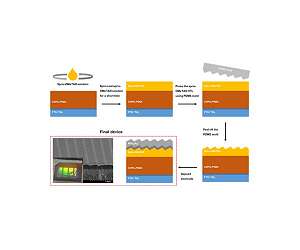The active layer morphology of organic solar cells (OSCs) serves as the bridge that connects material properties with device performances, and thus the morphology is of critical importance in device fabrication. State-of-the-art power conversion efficiencies (PCEs) of OSCs based on p-type donor polymers and n-type non-fullerene acceptors (NFAs) forming multi-length-scale fibril interpenetrating networks are above 19% (Nature Materials, 2022, DOI:10.1038/s41563-022-01244-y). Such a morphology, composed of pure fibrillar phases and the mixing phase of donor and acceptor molecules, combines the advantages of individual materials to achieve a balanced optimization for carrier generation and transport.
Despite the success in achieving high PCEs, precisely control over the blended thin film morphology is still a difficult task. Meanwhile, the fibril-based morphology-performance relationship remains unclear. To address these difficulties, the authors introduce a generalized multi-length-scale morphology model, and compare with uniform mixing model and binary phase model for investigating the structure-property relationship of OSCs.
Firstly, the authors change the period width of binary phase and multi-length-scale morphology. For binary morphology, with the increase of period width, the decreased exciton dissociation ratio (f ) results in the reduction of short circuit current (JSC); severe exciton-charge annihilation and minority carrier recombination hinders carrier transport and depresses filling factor (FF); both processes simultaneously reduce the open circuit voltage (VOC).
Under the same period width, the multi-length-scale morphology model has a higher f compared with the binary phase morphology. The relative narrow pure phase width reduces exciton annihilation during the exciton diffusion process in the pure phase. However, the mixing phase with relatively low carrier mobility is detrimental to carrier transport.
Reduced exciton loss and increased carrier recombination are in competition when introducing the mixing phase. Thus, an optimized morphology that balances the proportion of mixing phase and pure phase to maximize the product of carrier generation and transport processes is key to promote device performances.
The authors then investigate the morphology optimization of multi-length-scale model. When the pure phase width is small, large mixing phase size diminishes the effective carrier transport channel width, causing serious recombination loss during carrier transport and collection. Thus, the devices performance is poor in such a mixing phase dominated morphology situation. With the appropriate increase of pure phase width, the exciton dissociation ratio does not decrease significantly, with efficient exciton diffusion maintained.
Moreover, the serious carrier recombination in the mixing phase is significantly mitigated, contributing to improved JSC and FF. The VOC is also enhanced, which is attributed to improved carrier generation and suppressed carrier recombination. When the pure phase width increases further, the exciton dissociation ratio decreases significantly to reduce carrier generation efficiency. Moreover, it aggravates exciton annihilation and minority carrier recombination process, which leads to the deterioration of JSC, FF, VOC and PCE.
To further confirm the simulation results, three representative OPV blends, PM6:Y6, PM6:IT4F, and PCE10:PCBM are used to carry out two set of experiments for changing period width and pure phase width, respectively. The detailed structure information is extracted by grazing incidence wide-angle X-ray scattering (GIWAXS) and resonant soft X-ray scattering (RSoXS).
It is difficult to precisely control period and fibril width, so approximately, the period width is tuned by changing D/A ratio, while the proportion of fibril and mixing phase width is adjusted by changing the solvent additive amount. All of experiment results are consistent with simulation results.
In conclusion, this work constructs three morphology models to systematically investigate structure-performance correlation, clearly visualizes the influence of structure details on devices performance parameters, clarifies both importance of crystalline phase and mixing phase, and points out the optimization direction of multi-length-scale morphology.
Research Report:The Structure-Performance Correlation of Bulk-Heterojunction Organic Solar Cells with Multi-Length-Scale Morphology
Related Links
School of Chemistry and Chemical Engineering, Frontiers Science Center for Transformative Molecules
All About Solar Energy at SolarDaily.com
|
We need your help. The SpaceDaily news network continues to grow but revenues have never been harder to maintain. With the rise of Ad Blockers, and Facebook – our traditional revenue sources via quality network advertising continues to decline. And unlike so many other news sites, we don’t have a paywall – with those annoying usernames and passwords. Our news coverage takes time and effort to publish 365 days a year. If you find our news sites informative and useful then please consider becoming a regular supporter or for now make a one off contribution. |
||
|
SpaceDaily Contributor $5 Billed Once credit card or paypal |
SpaceDaily Monthly Supporter $5 Billed Monthly paypal only |
|

![]()
Increasing efficiency of solar cells with more light absorption capacity
Daegu, South Korea (SPX) Jul 01, 2022
On the 11th (Wednesday), DGIST announced that the research team led by Professor Choi Jong-min of the Department of Energy Engineering at DGIST (President: Kuk Yang) enhanced light absorption capacities and photocurrent generation of solar cells by implementing a nano-structured electrode on the back of the perovskite quantum dot solar cell, which is in the limelight as a next-generation solar cell.
In addition, the team has systematically verified the correlation between the shape of the nanostru … read more
